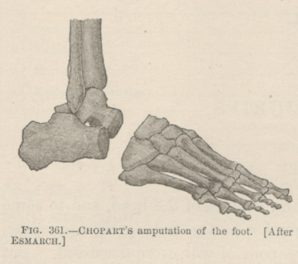Title: Hacket, S.
Source text: The Medical and Surgical History of the War of the Rebellion. (1861-65.), Part 3, Volume 2 (Washington, DC: Government Printing Office, 1883), 633.
Civil War Washington ID: med.d2e24423
TEI/XML: med.d2e24423.xml
CASE 933.—Private S. Hacket, Co. F, 11th Pennsylvania Reserves, aged 25 years, was wounded in the right foot, at Fredericksburg, December 13, 1862, by a round ball, which entered the sole near the third metatarsal bone, passed through the tarsus, and was extracted just anterior to the internal malleolus. He was admitted to Lincoln Hospital, Washington, ten days after receiving the injury, and Chopart's amputation was performed the following day. The patient's complexion was yellowish, his pulse rapid, and the color of his tongue light red and smooth. On December 29th he had a chill and complained of pain in his hips. There had been a few discharges of laudable pus and the stump looked well. On January 3d an abscess, which had been forming for three days, was lanced and bled profusely. During this time the patient had been costive and continued icteroid, the conjunctiva being of a pearly whiteness and his pulse moderately rapid, full, and regular. The granulations of the sore were more eminent and were bathed in a not unhealthy pus. His tongue on this day was furrowed, and during the morning he had a slight chill. On January 6th he had three chills, and the stump was inactive, the pus being white and cheesy. The abscess over the malleolus was now better, but the patient's skin was very yellow, with a brown tinge; tongue pale; countenance anxious. During the next three days he had one or two chills each day, and by this time he had become very feeble and his mind was wandering somewhat; pulse very rapid. The stump did not look very badly, but some hardness was noticed along the track of the vessels. By January 11th he was wholly delirious, which continued for two days, when he recovered his consciousness. The left pupil was now more dilated than the right; the stump was looking well, but was more swollen than at first. After this he became extremely exhausted and died January 15, 1863. The autopsy showed much emaciation. On opening the chest a large cavity was found just above the right lung, the top of it being lined with a greyish pus. Pleurisy with firm attachments existed on the right side, and there was partial pneumonia in the posterior lobe. A mass of separating dead tissue partially occupied the excavated space in the upper and anterior portion. The walls were lined with a thick and cheesy pus. Partial pneumonia with small circumscribed collections of pus existed in the lower lobe of the left lung posteriorly, while in the upper lobe anteriorly and at the middle there was a sharp-edged and deep excavation having separated dead tissue in it. The spleen was attached by fibrinous adhesions to the surface of the diaphragm and contained small circumscribed collections of pus. The liver was large, heavy, and mottled, with a distinct rough feel; kidneys natural and a little pale; inguinal glands greatly swollen. There was also a deep abscess below the popliteal space and unconnected with the stump. The amputated portion of the foot (Cat. Surg. Sect., 1866, p. 421, Spec. 4493) was contributed to the Museum by Assistant Surgeon G. M. McGill, U. S. A., who also recorded the history of the case.
